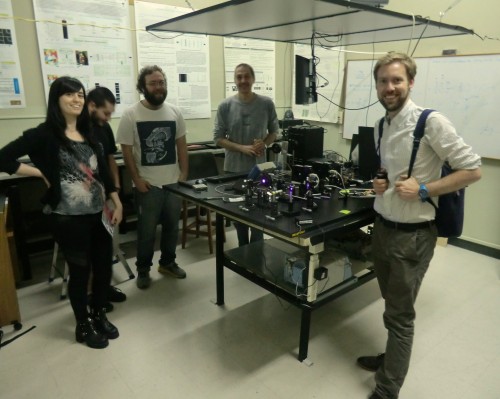
That’s me on the right visiting an optics lab at the University of Buenos Aires.
By James Dacey in Buenos Aires, Argentina
This week, physics PhD students and advanced undergraduates from across Argentina will flock to the University of Buenos Aires for the physics department’s winter school. It’s an annual event where budding researchers spend a few days at the nation’s premier academic institution to learn about some of the latest developments in fundamental research. The year, however, the meeting will be focused on bridging the gap between academia and industry.
I’ve been in Buenos Aires as part of a fact-finding mission to learn about the physics-education system in Argentina. After meeting with various people involved with Argentine physics education, it seems to me that the theme of this year’s winter school at the University of Buenos Aires is indicative of a change in the way physics is being presented to students. The subject is being rebranded from a purely intellectual pursuit into a practical science that can equip students with highly sought-after professional skills. The bigger picture, of course, is that right now the Argentine economy needs all the fresh ideas and workforce it can get!
To give you some context, here’s a fly-by tour of Argentine science in recent times, courtesy of a long chat with Pablo Mininni, director of the physics department at the University of Buenos Aires.
Argentina enjoyed something of a golden age for science from the mid-1950s to the early 1960s, when there was strong support from the government. Pioneering research done during this time led to two Nobel prizes: Luis Federico Leloir winning the chemistry prize in 1970 and César Milstein winning the award for physiology or medicine in 1984. It was also a good time for physics, with perhaps the most notable physicist from that era being Juan José Giambiagi, who helped to develop quantum field theory.
But following the military coups in 1966 and 1976, and their subsequent dictatorships, support for science was drastically reduced. Many scientists left the country, including Giambiagi, who went on to continue his influential work at the Brazilian Center for Physics Research in Rio de Janeiro. The lack of financial support and clear vision for science meant that Argentina didn’t have the necessary facilities, forcing the physics community to focus on theoretical subjects.
Democracy returned in 1983 and in recent years support for experimental physics has gradually started to come back, helped by the formation of the Ministry of Science, Technology and Innovative Production in 2007. “Scientists now have a direct line to the president,” Mininni told me. He was referring to the fact that the minister for science and technology is Lino Barañao, a chemist who holds a professorship at University of Buenos Aires.
Mininni says that during the past decade, the government has been upping its efforts to promote the applied areas of physics. “There is now a lot of support for scientists who are looking to move from basic research into more application-driven areas, as the ministry recognizes the importance to the economy,” he says.
But does this change in government mindset match students’ perceptions of the subject?
One undergraduate at the University of Buenos Aires, Rodrigo Cortiñas, told me that physics is viewed by many as being closer to philosophy than it is to more career-focused degrees such as engineering. Part of the reason why so many students lose interest in science at high-school level is that the subject is presented in a very abstract way, disconnected from the daily lives of the students. “The problem in teaching science at high-school level [in Argentina] is that they are teaching you to solve problems that you do not have. Why would you be interested in a solution to a problem you don’t have?” he says.
One of the aims of the winter school, which runs from 1–5 September, is to change the image of physics held by students and employers. At the time of my visit, 150 students had registered for the event, which is being backed financially by private industry and the Ministry of Science, Technology and Innovative Production. There will be 40 speakers representing 20 companies, half from the public sector and half from the private sector, including organizations from various industries including atomic energy, oil and nanotechnology.
“Students hear about the sort of physics going on at the LHC and come to university with an idea of getting into extremely fundamental physics,” says Esteban Calzetta, a quantum theorist who is the event co-ordinator at the University of Buenos Aires. “They don’t realize that there is a lot of really interesting physics research within industry.” Calzetta told me that the recruitment opportunities at the event will be explicit, with human-resources professionals attending as well as industrial scientists.
One of the organizations at the event will be a recently founded company called Y-Tec, which is run jointly by the national research council (CONICET) and the national oil company YPF Tecnologia. The firm was founded in 2013 to study a range of scientific areas relating to the oil industry, including extraction methods and the environmental impacts of techniques such as fracking. According to Mininni, Y-Tec has already employed several physics graduates from the physics department at the University of Buenos Aires.
In the end, not all of the students attending next week’s meeting will walk away with jobs. But it seems to me that the event will help to reinforce the physics rebrand that has been under way in Argentina over the past few years.
Trackback: Physics Viewpoint | Connecting physics with Argentine industry
Trackback: Blog - physicsworld.com